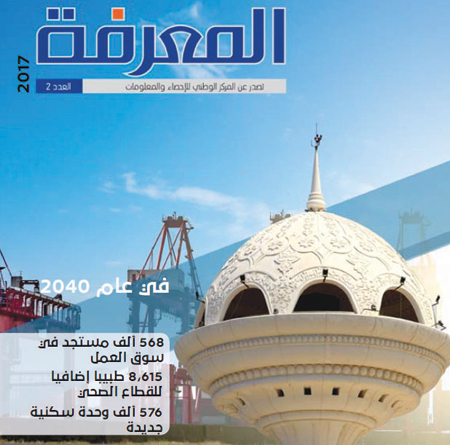

MUSCAT: In an effort to enhance the statistical knowledge in the Sultanate based on analysing data and indicators, the National Centre for Statistics and Information (NCSI) had come out with the second issue of Knowledge which reviews the comprehensive developmental needs of the various governorates until 2040.
The review aims to put in perspective the long-term future vision of each governorate in various spheres, such as logistics, tourism, education and other prominent social indicators. This will help in determining the developmental needs of each and every governorate.
The publication of the second issue on Knowledge coincides with the second year of the Ninth Five-Year Developmental Plan (2016-2020). Reviewing the most important indicators at the governorates level will play a big role in putting into focus the priorities and pillars of the Five-Year Plan, as a major target is to channel investments and activities to Governorates outside Muscat.
Under the title ‘Al Dakhiliyah: Diversity in history, culture and topography’, the data shows that Al Dakhiliyah will witness continuous development and infrastructure construction to meet the residents’ needs. The estimated future need of water and electricity in the governorate, for domestic use, is around 1.1 billion gallons of water and 6,500 GW/H of electricity to maintain the current rates of consumption.
Under the title of: ‘North Al Batinah: Active in trade and promising projects’, it highlights 112,000 new candidates joining the job market during the coming 25 years, an average of 4,480 new entries per year. The governorate during the next 25 years, need around 12,700 teachers and 4,300 classes to meet the needs of around 116,000 additional students, 2,196 doctors and 4,325 nurses.
The data estimates that the residents of South Al Batinah will need more than 1,000 gallons of water by 2040 for domestic use. The governorate will additionally need 53,000 residential units during the next 25 years, in case the current population density per residence unit is maintained. Additionally, the governorate will need 7,800 teachers and 2,600 classes to meet the needs of around 70,000 students, 1,207 doctors and 2,377 nurses.
Under ‘South Al Sharqiyah, the facade of the marine commerce’, it estimates that 46,000 new job-seekers will enter the market with an annual average of 1,824 new candidates. This is in accordance with the additional need for 5,162 new teachers and 651 new classes to meet the needs of more 47,000 additional students throughout the next 25 years. Moreover, to maintain the level of care and health services there is an additional need for 889 doctors and 1,161 nurses.
On North Al Sharqiyah, the data shows that there is an additional expected need of 4,468 teachers, 516 classes, in order to meet the needs of an additional 41,000 students during the next 25 years. There will be a need of 806 doctors and 1,052 nurses. The governorate will need 683 million gallons of water and 5,000 GW/H of electricity in order to maintain the current ratios of consumption during the next 25 years.
Under the title ‘Home to historical forts and ruins’, it reviews the indicators that point out the Governorate of Al Dhahirah is going to see a demand for 34,000 new jobs with 1,379 new candidates entering the market annually. Moreover, the expected need of the additional residential units in the next 25 years is estimated to be at 27,000 units if the same population for each unit is maintained. This takes annual average to 1,082 residential units.
Under the title of ‘Al Wosta will promote the economic diversity’, it shows that 5,500 new candidates will enter the job market in the governorate with an annual average of 1,221 new job-seekers. Moreover, the expected need of the additional residential units through the next 25 years is estimated to be around 6,000 if the same population for each residential unit, which is an average of 234 per unit, is maintained.
Knowledge is part of NCSI’s attempt to promote the culture of using statistical data in society in partnerships with all segments of the Omani society and in accordance with maintaining high levels of professionalism that makes the statistical analysis by the Sultanate a role model to be emulated regionally and internationally.
— ONA
Oman Observer is now on the WhatsApp channel. Click here



